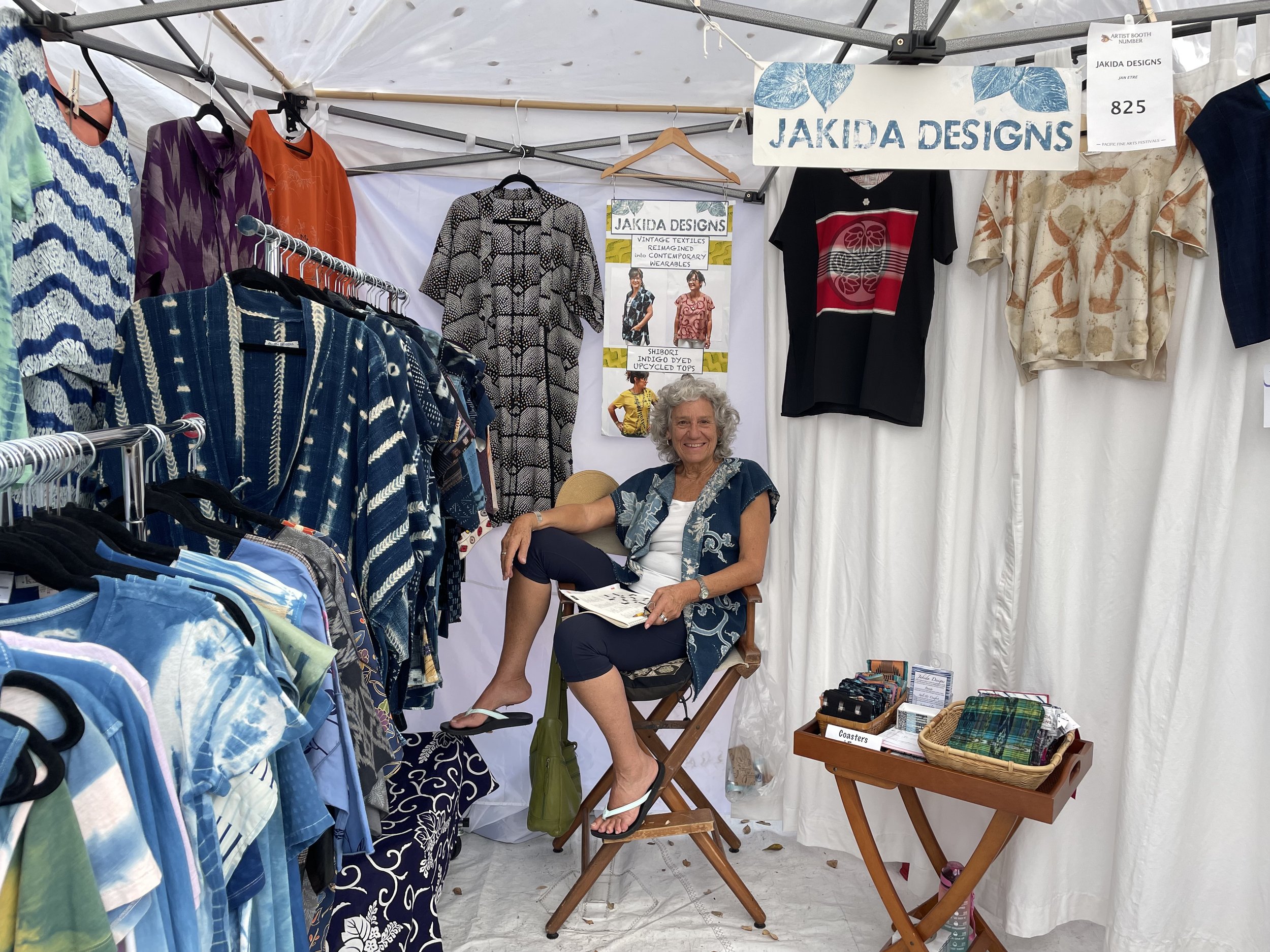About Jan Etre: Refashionista
Enjoying being in my booth at the San Carlos, CA, Art & Wine Faire, October 2024.
Passionate about upcycling ethnic textiles into contemporary wearables, I design clothing from vintage African, Japanese and Thai cloth, mostly cottons. I also Shibori dye using both vintage silks and pre-made clothing. Almost all of my work includes indigo-dyed fabric.
Shibori in Japan and Adire in Africa: both refer to a resist used on the fabric prior to dyeing. The resist can be stitched, tied, waxed, pasted, clamped, and combinations of all these.
My vest and jacket designs are based on the silhouette of the Japanese kimono, yet are Westernized for style and fit. My tops are boxy, like a huipil. In all cases the fabric is used to its utmost; there’s very little waste.
Varieties of indigo are grown on almost every continent; there are over 900 known varieties. The dye is in the leaves of the plant. Indigo is one of the primary original natural dyes. Growing it formed a part of the economy of the American South during slavery, and decimated the then-established production in India, causing a famine there. Like cotton and tobacco, indigo was farmed by enslaved people. The US as a dominating world economy was created by forced and unpaid labor. We cannot escape the history of this country, nor should we ever turn a blind eye to the reality of it! The chemical equivalent of indigo was discovered by a German chemist in 1897, and since then denim has become one of the world’s most popular textiles, and shows no sign of declining. At this time only about 4% of the world’s indigo dye is natural. The synthetic version is terribly polluting from start to finish, and is manufactured in China.
The textile industry on the whole is the second most polluting industry on the planet, after fossil fuels. How can that be? Virtually everyone wears clothes, for one, and in the modern world we all have so many clothes, whether of natural or synthetic fabric, and they cycle in and out of our closets regularly. Where do the cast-offs land? In landfill, or in poorer countries, displacing their ethnic clothing because of the cheaper cost. This is not a small problem.
I like to wear my values, meaning that I am concerned about the environmental and human rights impact of continually buying (and then discarding) new clothes. I prefer to celebrate my style with more signature pieces of higher quality. The materials are “found” rather than bought. (I generally do not buy new fabric.) They are re-purposed into new designs that are contemporary, attractive and comfortable. They can be loved and worn for a lifetime.
The vintage Japanese and African textiles that I am currently working with were made to last hundreds of years; in fact, much of these materials are almost one hundred years old already, showing the refinement that only time can bring to a textile. Textiles are no longer produced the way they were back then: technology, dyes, culture and economies are constantly changing and the making of these textiles is no exception to the forces of change. Therefore, these will become more rare. I feel privileged to be using these fabrics, which I honor by slowly and painstakingly redesigning them into wearable art. I often sew by hand, which is calming, and adds to the distinctiveness of the clothes I create.
I have always loved to sew. Recently someone asked me when I started sewing. I had to ponder that for a while, until I recalled making doll clothes and looking at patterns when I was maybe 8 or 9 years old. With four sisters, all close in age, I was the designated jeans-pegger in high school. I remember sitting at my mother’s Singer (which was like a piece of furniture as it folded into its own cabinet when not in use), and custom fitting jeans’ legs for my sisters. Six decades later I am still making clothes, and my love of textiles has morphed into refashioning vintage textiles into comfortable, easy to wear clothing for women: tops, vests and jackets. Also, I became crazy about indigo and Shibori dyeing after a trip to India in 2017, where I was introduced to both.
Sewing face masks during the pandemic. Oh, so many face masks! | photo by: Kirk Foster.
It seems I cannot have too much fabric. At least I can say it’s well organized! (This is a mere sampling.) | photo by: Kirk Foster.


